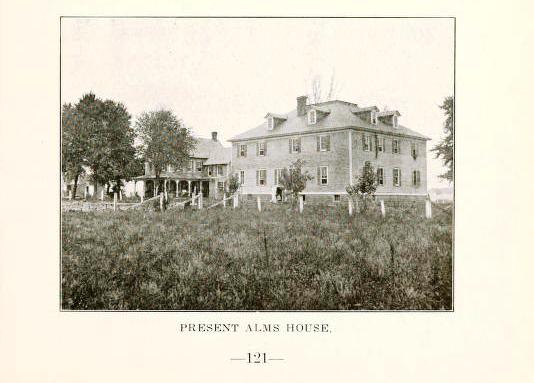For fourteen years after Caroline’s
organization we find the Court records filled with such items as
these:
Ordered by the court that Nancy
P---- be allowed in next year’s levy at the
rate of 6 shillings for her support.
Ordered that there be levied in the next levy the sum of £20 to James
J---- for burying Rebecca S----,
finding coffin, sheet etc.
Ordered by the court that 64 Lbs. of tobacco a month be paid to Mary
B---- for support of Levi T---- now
3 years old, orphan son of Sarah T---- now
deceased.
In spite of large sums thus granted for this use the poor in
the county were not properly cared for. To remedy this, in November
1788 the General Assembly passed a law requiring that there be an
alms and work house built at the general expense of the county. The
justices were to assess and levy the sum of £300 current money in
each year from 1789 to 1790 to meet this expense. An annual levy
was to be made for the running expense of the institution.
William Whitely, Joseph Douglass, Thomas
Hardcastle, Joshua Wallace and Henry
Downes were appointed trustees to purchase land and
erect thereon suitable buildings for the institution. The land
selected consisted of six acres of a tract of land known as Lloyd’s
Regulation about one-half mile from Denton on the road which led to
Potter’s Landing (Williston). It was purchased from John
Cooper and Michael Lucas for
£18 current money. Of the original buildings we know little except
that the main one was a splendidly built brick house surrounded by
numerous smaller ones of frame. While the buildings were being
erected, the trustees were authorized to rent a house near the
county seat for the reception of the poor and such vagrants as
should be committed to their charge.
The trustees were responsible for the good government of the
alms and work houses. The poor were kept in the alms house and such
as were able were compelled to work, while the work house lodged the
vagrants, beggars, vagabonds and disorderly people of the county.
They, too, were compelled to work and in case of misbehavior were at
one time subjected to ten lashes of the whip. Later, however, this
punishment was changed to an extension of time in the institution.
An overseer was appointed with a salary of £75 annually
beside food, fuel, and house room for himself and family. He kept a
record of all persons committed to his care, all expenses for their
support, and such monies as he received from their labor. He was
also responsible for the general management of the place in the
absence of the trustees.
When a man or woman was committed to either house he was
forced to wear upon the shoulder of the right sleeve of his top
garment a badge bearing the Roman letters P.C. cut into red or blue
cloth. There was a punishment for refusal to wear the badge and a
fine for the overseer allowing anyone to omit it.
It was found necessary to make provision for
out-pensioners. These were people who could be cared for more
conveniently in private homes than in a public institution. An
allowance of not more than $30 annually was to be paid each of them
and at no time was the number of out-pensioners to exceed ten. Such
orphans as were committed to the poor house were, upon opportunity,
bound out to tradesmen or mechanics who promised to feed, clothe,
and lodge them as well as instruct them in their trade.
|
|
In 1823 there was a general feeling in the county that there was
not land enough at the Alms-house farm and that a larger tract, properly
tilled, would be more satisfactory. Accordingly, the old property was
sold at public auction for $505 to Mr. James Dukes and
remodeled by him for private use. The brick building, which is in
excellent condition, is still owned by the heirs of the original
purchaser. The land purchased for the new farm contained 325 acres,
known as the George Garey Farm, the
price paid being $2197.581/2. Since that time some of the
wooded land has been cleared, the timber sold and additional land
purchased. |
